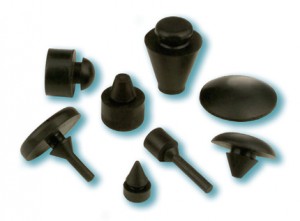 Rubber bumpers don’t directly interact with any wiring you’ll be installing or working with. However, they do have an affect on the wiring. They can be used in one of two ways. They can either be use to plug holes, preventing air, water, and anything else from getting through – this will keep your wires safe from the elements and prevent any malfunctions. They can also be used as feet for equipment to stand on – your equipment will then be stable and will have less chance of affecting your wiring. There are several types of rubber bumpers out there. Here’s an overview of a few of the major types.
Rubber bumpers don’t directly interact with any wiring you’ll be installing or working with. However, they do have an affect on the wiring. They can be used in one of two ways. They can either be use to plug holes, preventing air, water, and anything else from getting through – this will keep your wires safe from the elements and prevent any malfunctions. They can also be used as feet for equipment to stand on – your equipment will then be stable and will have less chance of affecting your wiring. There are several types of rubber bumpers out there. Here’s an overview of a few of the major types.
Push-in Rubber Bumpers
Push-in bumpers come in various shapes. The one you need depends on the size of the hole you need to plug. You want to make sure the hole is air tight so be sure to choose the right one – or just buy a set so you have a variety. There are thick cone-shaped push-in rubber bumpers for larger holes. There are rubber bumpers that have a thin protrusion to fit through a smaller hole with a wide top to cover the entire hole. These push-in bumpers can also be used as feet.
Rubber Pocket Bumpers
Rubber pocket bumpers are called pocket bumpers because well, they have a pocket in the center of them. They come in various sizes from very small to very large. The larger sizes are larger and thicker than any other bumper and are meant to plug larger holes. The smaller sized rubber pocket bumpers are for thinner surfaces. All sizes dampen vibrations. Finally, rubber pocket bumpers are perfect for using as feet to secure various pieces of equipment. They’re thick, sturdy, and will keep your equipment from sliding or moving.
Adhesive Backed Bumpers
Adhesive backed bumpers allow for the easiest installation. All you need to do is peel off the back and press it into place. There are no holes to drill and no screws to screw. They’re also very versatile. They can stick to a wide variety of surfaces: aluminum, ceramic, formica, glass, painted surfaces, polyethylene, polypropylene, vinyl, and steel. Even better, they won’t leave marks on any of those surfaces when removed. Just make sure to thoroughly clean the surface before you place the bumper on the surface – this will ensure it sticks the way it is designed to.
Snap-in Bumpers
While snap-in bumpers are not as easy to install as adhesive backed bumpers, they’re still very easy and provide better hold than all of the other bumpers. Once snapped into the surface, it will have a snug, secure fit. Like adhesive backed bumpers, they won’t leave any marks. They also provide extremely strong support.
Those are the major types of rubber bumpers. With a variety to choose from, just make sure to pick the best one for your unique situation.
